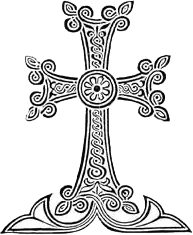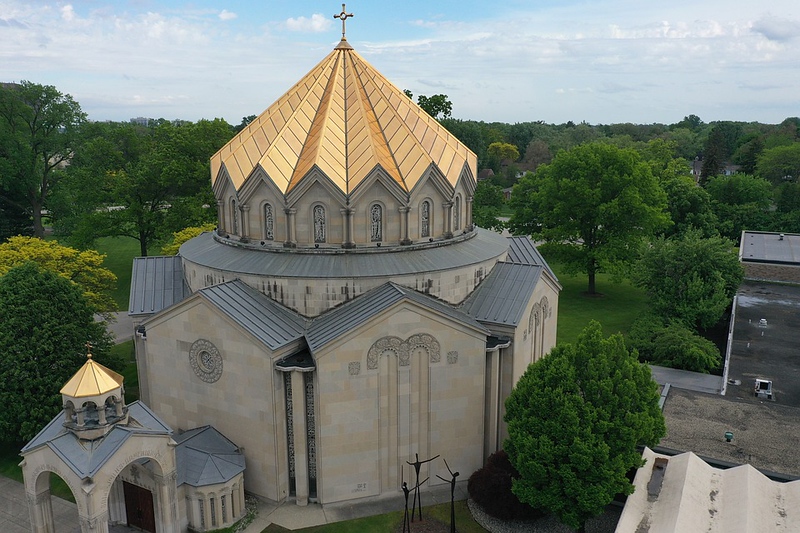The Functional Structure of the Armenian Church
The functional structure of the Armenian Church is primarily based on the canons and established traditions of the Armenian Church, which were formulated over the centuries. One of the most important aspects of the Armenian Church administration is its conciliar system. In other words, the administrative, as well as doctrinal, liturgical, and canonical norms are set and approved by a council ― collective and participatory decision-making process. Indeed, conciliarity in decision-making is a significant aspect in the Book of Acts 15. The Council of Bishops (or Synod) is the highest religious authority in the Church.
The norms of the administrative structure of the church go back to the Apostolic times. The apostles continued the mission entrusted to them by Christ. Eventually, as the church progressed from being a persecuted entity of believers to an institutionalized organization, the rules and admonitions of “the apostles and the elders” (Acts 15:6) were integrated in the canon books of Christian churches, including the Armenian Church.

The Hierarchical Structure of the Armenian Church
Clerical Hierarchy
• Catholicos
• Bishop
• Priest
Lay Representation
• National Ecclesiastical Assembly
• Diocesan Assembly
• Parish Assembly
The Catholicos – First on the hierarchical ladder is the Catholicos, as the Chief Bishop and Supreme head of the Armenian Church. The Catholicos is elected for life by a National Ecclesiastical Assembly (NEA), consisting of lay and clergy representatives of the Armenian Churches from around the world. The Catholicos is the chief administrator of religious, spiritual, ecclesiastical and administrative matters and oversees the decision-making processes over dogmatic, liturgical and canonical issues. He has exclusive authority to bless the Holy Muron (chrism), to consecrate bishops, approve the election of diocesan prelates, discipline clergymen, and other related matters. In the Middle Ages, the Catholicos also anointed the kings of Cilician Armenia. Working closely with the Catholicos is the Supreme Ecclesiastical Council, (the administrative arm of NEA) which carries out the overall administration of the Armenian Church throughout the world.
The Bishop – Second on the hierarchical ladder is the bishop, who is “elected” by the people and consecrated by the Catholicos with the aid of two other bishops (according to current practice, the Catholicos has exclusive right to consecrate bishops). A bishop in a given diocese is the “chief executive officer” of a given country or region, who works in cooperation with a Diocesan Council (consisting of clergy and lay members), who in turn are elected by the Diocesan Assembly of the region. The Bishop is the ex-officio president of every Diocesan organization.
The Priest – Third on the hierarchical ladder is the priest, who is appointed by the Bishop and accepted by the Parish Assembly of a given parish. The parish priest is the ex-officio president of every Parish organization. “Monastic priests” or celibate priests (vardapets) would normally be members of a Brotherhood of the Hierarchical Sees in Etchmiadzin, Antelias, Jerusalem or Constaninople and are under the jurisdiction of the Catholicos or the Patriarch of a given See.
The National Ecclesiastical Assembly – The National Ecclesiastical Assembly (NEA) — the highest legislative body of the Armenian Church — is made of two-thirds lay representatives of the Armenian nation and one-third clergymen. Delegates to the NEA are elected by the Diocesan Assemblies of the dioceses of the Armenian Church or communities around the world. Every bishop in the Armenian Church is automatically a member of the Assembly. The Catholicos ― or in his absence the Locum Tenens ― is ex-officio president of the NEA. The primary function of the NEA is to elect a successor to a deceased Catholicos. The last three NEAs were convened in 1955, 1995 and 1999 to elect the Catholicos of All Armenians in Etchmiadzin.
The Diocesan Assembly – The Diocesan Assembly consists of lay delegates elected by the Parish Assemblies. Every diocesan clergy is automatically a member of the Assembly. The Diocesan Primate is ex-officio president of the Diocesan Assembly.
The Parish Assembly – The Parish Assembly consists of all baptized and/or dues paying members of a given parish in a given diocese. The Pastor is the ex-officio president of the Parish Assembly.
On each level on the hierarchical structure of the Armenian Church, clergy and lay cooperation is central to the overall administration and ministry of the church. While the Church is governed according to the standards set forth in the Canons, there are complementary By-Laws in most dioceses that further define the role and relationship of each functionary in the church within a given region.
The Hierarchical Sees of the Armenian Church
• The Catholicosate of All Armenians in Etchmiadzin (established by St. Gregory the Illuminator in the 4th century).
• The Catholicosate of the Great House of Cilicia (established in Antelias, Lebanon in 1930, but its roots go back to the 13th century).
• The Patriarchate of Jerusalem (the St. James Brotherhood established the Patriarchate at the beginning of the 14th century).
• The Patriarchate of Constantinople (established in 1461 by Sultan Mehmet II).
The Catholicosate of All Armenians, also known as the Mother See of Holy Etchmiadzin, is the supreme ecclesiastical centre of the Armenian Church. It is recognized as the ‘pre-eminent’ among the four Hierarchical Sees of the Church.
The Catholicos of Cilicia is equal in rank, but recognizes the primacy of honor of the Catholicos of All Armenians in Etchmiadzin. The heads of both Sees are consecrated by the same rite of the Church and enjoy the same privileges of a catholicos, namely, the consecration of bishops and blessing of Holy Muron.
The Patriarchs of Jerusalem and Constantinople have the rank of Archbishop. They are autonomous in the internal affairs of their Patriarchates and pledge canonical allegiance to the Catholicosate of All Armenians.
Each See has its own brotherhood, ecclesiastical jurisdiction and internal administrative by-laws. They are not separate churches, but are part of the One, Holy, Apostolic Church ― the Armenian Church ― and are one in dogma, theology, liturgy and rendered services.
While the overwhelming majority of Armenians are members of the Armenian Apostolic Church (at least nominally), there are also Armenians belonging to Armenian Catholic and Protestant (Evangelical) churches.
-by Hratch Tchilingirian

